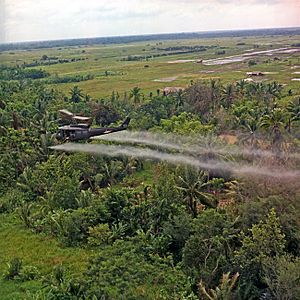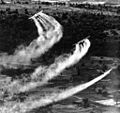Agent Orange facts for kids
Agent Orange is a strong chemical that kills plants and trees. It's a type of herbicide (weed killer) and defoliant (something that makes leaves fall off). It was one of several "Rainbow Herbicides" used by the U.S. military. This chemical is most famous for being used during the Vietnam War from 1961 to 1971. This was part of a program called Operation Ranch Hand.
The U.S. military used Agent Orange to destroy forests. This was done so their enemies would have fewer places to hide.
Contents
What is Agent Orange?
Agent Orange is a chemical that makes leaves fall off trees and destroys forests. The U.S. military used it to clear areas where their enemies might be hiding.
The problem with Agent Orange is that it also creates harmful chemicals called dioxins. Dioxins are very dangerous and stay in the environment for a long time. They can cause serious health problems, including changes to a person's genes and different types of cancer.
Agent Orange and the Vietnam War

Many people in Vietnam were exposed to Agent Orange, possibly up to 4 million. About 1 million of them now have serious health issues. The chemical can damage genes, which has led to birth defects in children of those who were exposed. The U.S. government has also found more cases of leukemia (a type of blood cancer), Hodgkin's lymphoma, and other cancers in U.S. soldiers who were exposed.
Agent Orange also caused huge damage to Vietnam's environment. Over 31,000 square kilometers (about 12,000 square miles) of forest were destroyed. When the trees were gone, the soil was easily washed away, making it hard for new trees to grow. The number of different animal species also dropped sharply in areas that were sprayed.
After the war, there were many legal issues because of Agent Orange. The United Nations created rules like the Environmental Modification Convention to prevent similar harm in the future. Lawsuits were filed by both U.S. and Vietnamese veterans seeking help for the harm caused by the chemical.
Where Else Was Agent Orange Used?
Agent Orange was also used in smaller amounts outside of Vietnam. Some countries, like Canada, tested the chemical. Other countries, such as Brazil, used it to clear land for farming. Forests in Laos and Cambodia were also sprayed because they were used by the Viet Cong (the enemy forces in Vietnam).
Cleaning Up Agent Orange
Companies involved in making Agent Orange have had to pay for cleanup efforts. For example, in 2012, Monsanto agreed to pay for cleaning up dioxin pollution around a factory in West Virginia that made Agent Orange. They also paid for medical checks for affected people.
The United States and Vietnam began working together in 2012 to clean up Agent Orange at Da Nang International Airport. This airport was a main storage site for the chemical. This was the first time the U.S. helped directly with cleanup in Vietnam.
They are also looking at other cleanup sites, like Biên Hòa and Phù Cát airport in Vietnam, which are "hotspots" for dioxin. The U.S. government has given money to help reduce the contamination in the soil there.
In the U.S., a large storage site for Agent Orange was at the Seabee's Naval Construction Battalion Center in Mississippi. This site was still being cleaned up in 2013. In 2016, the U.S. Environmental Protection Agency (EPA) planned a large cleanup of an 8-mile stretch of the Passaic River in New Jersey, which was also contaminated. This area was named a Superfund site, meaning it's a very polluted place that needs a lot of cleanup.
Images for kids
-
U.S. Army Huey helicopter spraying Agent Orange over agricultural land during the Vietnam War in its herbicidal warfare campaign.
-
Map showing locations of U.S. Army aerial herbicide spray missions in South Vietnam taking place from 1965 to 1971.
-
The Ivon Watkins-Dow factory in New Plymouth, New Zealand.
-
Leaking Agent Orange barrels at Johnston Atoll circa 1973.
-
Rusting Agent Orange barrels at Johnston Atoll, circa 1976.
-
A scientific study of the effects military contamination at Johnston Atoll included a statement confirming records of Agent Orange storage in Okinawa.
-
Excerpt of U.S. Army 1971 Fort Detrick report describes Tactical Herbicide stockpiles of U.S. Government restricted materials on Okinawa at Kadena AFB, in Thailand, and Vietnam.
-
Defoliant spray run, part of Operation Ranch Hand, during the Vietnam War by UC-123B Provider aircraft.
See also
 In Spanish: Agente Naranja para niños
In Spanish: Agente Naranja para niños

















